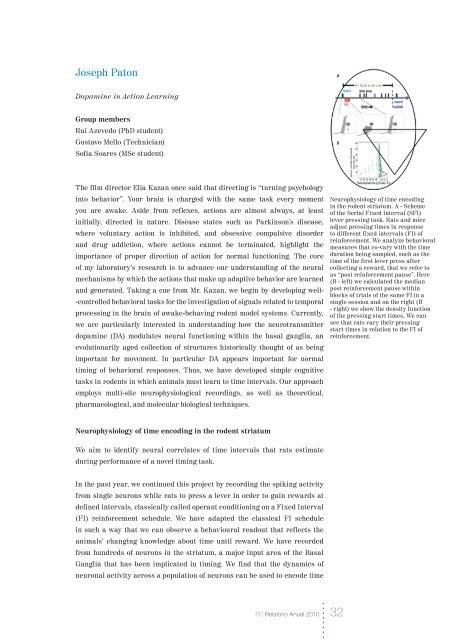Relatório Anual 2010 - Fundação Champalimaud
Relatório Anual 2010 - Fundação Champalimaud
Relatório Anual 2010 - Fundação Champalimaud
You also want an ePaper? Increase the reach of your titles
YUMPU automatically turns print PDFs into web optimized ePapers that Google loves.
Joseph PatonDopamine in Action LearningGroup membersRui Azevedo (PhD student)Gustavo Mello (Technician)Sofia Soares (MSc student)The film director Elia Kazan once said that directing is “turning psychologyinto behavior”. Your brain is charged with the same task every momentyou are awake. Aside from reflexes, actions are almost always, at leastinitially, directed in nature. Disease states such as Parkinson’s disease,where voluntary action is inhibited, and obsessive compulsive disorderand drug addiction, where actions cannot be terminated, highlight theimportance of proper direction of action for normal functioning. The coreof my laboratory’s research is to advance our understanding of the neuralmechanisms by which the actions that make up adaptive behavior are learnedand generated. Taking a cue from Mr. Kazan, we begin by developing well--controlled behavioral tasks for the investigation of signals related to temporalprocessing in the brain of awake-behaving rodent model systems. Currently,we are particularly interested in understanding how the neurotransmitterdopamine (DA) modulates neural functioning within the basal ganglia, anevolutionarily aged collection of structures historically thought of as beingimportant for movement. In particular DA appears important for normaltiming of behavioral responses. Thus, we have developed simple cognitivetasks in rodents in which animals must learn to time intervals. Our approachemploys multi-site neurophysiological recordings, as well as theoretical,pharmacological, and molecular biological techniques.Neurophysiology of time encodingin the rodent striatum. A - Schemeof the Serial Fixed Interval (SFI)lever pressing task. Rats and miceadjust pressing times in responseto different fixed intervals (FI) ofreinforcement. We analyze behavioralmeasures that co-vary with the timeduration being sampled, such as thetime of the first lever press aftercollecting a reward, that we refer toas “post reinforcement pause”. Here(B - left) we calculated the medianpost reinforcement pause withinblocks of trials of the same FI in asingle session and on the right (B- right) we show the density functionof the pressing start times. We cansee that rats vary their pressingstart times in relation to the FI ofreinforcement.Neurophysiology of time encoding in the rodent striatumWe aim to identify neural correlates of time intervals that rats estimateduring performance of a novel timing task.In the past year, we continued this project by recording the spiking activityfrom single neurons while rats to press a lever in order to gain rewards atdefined intervals, classically called operant conditioning on a Fixed Interval(FI) reinforcement schedule. We have adapted the classical FI schedulein such a way that we can observe a behavioural readout that reflects theanimals’ changing knowledge about time until reward. We have recordedfrom hundreds of neurons in the striatum, a major input area of the BasalGanglia that has been implicated in timing. We find that the dynamics ofneuronal activity across a population of neurons can be used to encode timeFC Relatório <strong>Anual</strong> <strong>2010</strong> 32



